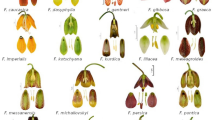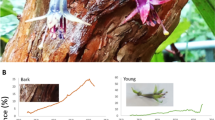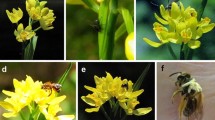Summary
Rare “albino” morphs of the montane larkspur Delphinium nelsonii differ from common blue-flowered morphs in overall flower color, and in the strength of a contrasting color pattern at the center of the flower that presumably guides pollinators to concealed nectar. Previous studies showed that bumblebees and hummingbirds discriminate against albinos when presented with mixtures of the 2 morphs, and that it takes these pollinators longer to fly between successive flowers on albino than on blue-flowered inflorescences. To explore the link between these observations, we measured pollinator preferences and flower-to-flower flight times (“handling times”) before and after painting flowers in 2 alternative ways that enhanced albino nectar guides. In all of 16 experimental replicates discrimination against albinos was reduced or eliminated after painting, and albino handling times declined toward values for blue-flowered inflorescences. This consistent result indicates that an inferior nectar guide increases the energetic cost of foraging at albinos. Increased cost in turn explains discrimination, under the reasonable assumption that hummingbirds and bumblebees are sensitive to foraging economics.
Similar content being viewed by others
References
Chen D, Collins JS, Goldsmith TH (1984) The ultraviolet receptor of bird retinas. Science 225:337–340
Daumer K (1958) Blumenfarben, wie sie die Bienen sehen. Z vergl Physiol 41:49–110
Emlen JM (1966) The role of time and energy in food preference. Amer Natur 100:611–617
Emlen JM (1968) Optimal choice in animals. Amer Natur 102:385–390
Goldsmith TH (1980) Hummingbirds see near ultraviolet light. Science 207:786–788
Goldsmith TH, Goldsmith KM (1979) Discrimination of colors by the black-chinned hummingbird (Archilochus alexandri). J Comp Phys 130:209–220
Harder LD (1983) Flower handling efficiency of bumblebees: Morphological aspects of probing time. Oecologia (Berlin) 57:274–280
Hodges CM, Wolf LL (1981) Optimal foraging in bumblebees: Why is nectar left behind in flowers? Behav Ecol Sociobiol 9:41–44
Jones CE, Buchmann SL (1974) Ultraviolet patterns as functional orientation cues in hymenopterous pollination systems. Anim Behav 22:481–485
Jones CE, Rich PV (1972) Ornithophily and extrafloral color patterns in Columnea florida Morton (Gesneriaceae). Bull Southern California Acad Sci 71:113–116
Kay QON, Daoud HS, Stirton CH (1981) Pigment distribution, light reflection and cell structure in petals. Bot J Linn Soc 83:57–84
Kevan PG (1972) Floral colors in the high arctic with reference to insect-flower relations and pollination. Can J Bot 50:2289–2316
Kevan PG (1983) Floral colors through the insect eye: What they are and what they mean. In: Jones CE, Little RJ (eds) Handbook of experimental pollination biology, Van Nostrand Reinhold, New York, pp 3–30
Kugler H (1943) Hummeln als Blütenbesucher. Ergebn Biol 19:143–323
Kugler H (1963) UV-Musterungen auf Blüten und ihr Zustandekommen. Planta 59:296–329
Laverty TM (1980) The flower-visiting behaviour of bumble bees: Floral complexity and learning. Can J Zool 58:1324–1335
MacArthur RH, Pianka ER (1966) On optimal use of a patchy environment. Amer Natur 100:603–609
Macior LW (1975) The pollination ecology of Delphinium tricorne (Ranunculaceae). Amer J Bot 62:1009–1016
Mazokhin-Porshnyakov GA (1969) Insect vision. Plenum, New York
Mulligan GA, Kevan PG (1973) Color, brightness, and other floral characteristics attracting insects to the blossoms of some Canadian weeds. Can J Bot 51:1939–1952
Platt JR (1964) Strong inference. Science 146:347–353
Price MV (1985) Structure of desert rodent communities: A critical review of questions and approaches. Amer Zool (in press)
Scora RW (1964) Dependency of pollination on patterns in Mondarda (Labiatae). Nature 204:1011–1012
Siegel S (1956) Nonparametric statistics for the behavioral sciences. McGraw-Hill, New York
Sprengel CK (1793) Das entdeckte Geheimniss der Natur im Bau und in der Befruchtung der Blumen. Vieweg, Berlin
Waser NM (1983) The adaptive nature of floral traits: Ideas and evidence. In: Real LA (ed), Pollination biology, Academic Press, New York, pp 241–285
Waser NM, Price MV (1981) Pollinator choice and stabilizing selection for flower color in Delphinium nelsonii. Evolution 35:376–390
Waser NM, Price MV (1983) Pollinator behaviour and natural selection for flower colour in Delphinium nelsonii. Nature 302:422–424
Author information
Authors and Affiliations
Rights and permissions
About this article
Cite this article
Waser, N.M., Price, M.V. The effect of nectar guides on pollinator preference: experimental studies with a montane herb. Oecologia 67, 121–126 (1985). https://doi.org/10.1007/BF00378462
Received:
Issue Date:
DOI: https://doi.org/10.1007/BF00378462




